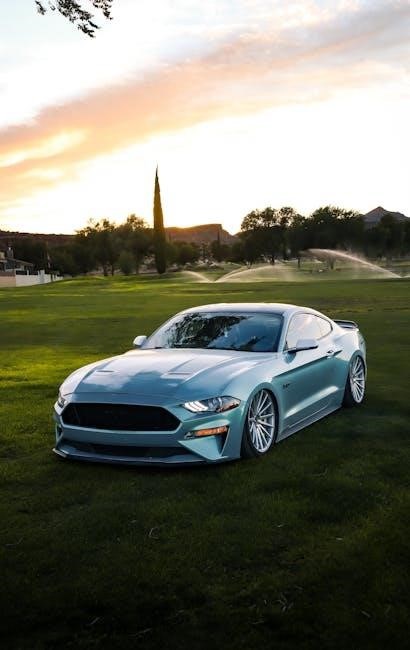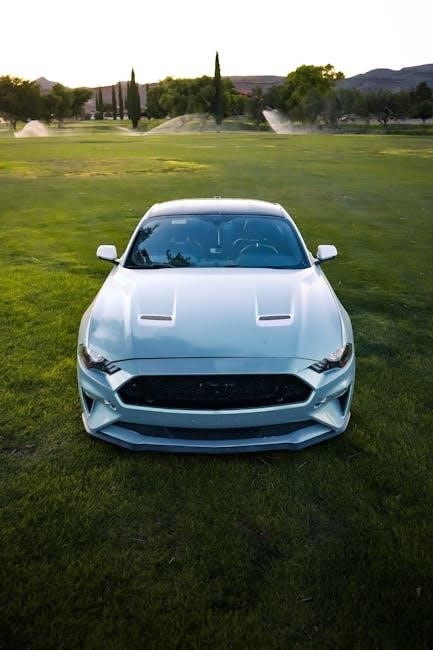Proper charging is essential for maintaining your Club Car golf cart’s performance and longevity. This guide provides step-by-step instructions, safety tips, and best practices for efficient charging.
Overview of Club Car Golf Cart Charging
Club Car golf cart charging is a straightforward process when done correctly, ensuring optimal performance and longevity of the vehicle. The charging system typically includes a charger, battery, and onboard computer. It is designed to safely recharge deep-cycle, lead-acid batteries, which power the cart. Proper charging involves plugging the charger into a standard electrical outlet and allowing it to cycle through its stages. The process is automated, but monitoring is recommended to avoid overcharging. Safety standards and manufacturer guidelines must be followed to prevent damage or hazards. Regular charging after each use and maintaining water levels are crucial for battery health. Always refer to the owner’s manual for specific instructions tailored to your Club Car model. Improper charging can lead to reduced battery life or even void the warranty. By following best practices, you can ensure reliable operation and extend the lifespan of your golf cart.
Key Considerations Before Charging
Before charging your Club Car golf cart, several factors must be considered to ensure safety and efficiency. First, always refer to the owner’s manual for model-specific instructions. Check the battery water levels and top them off with distilled water if necessary. Ensure the charger is compatible with your cart’s voltage and battery type. Verify that the charging area is well-ventilated and free from flammable materials. Avoid charging in extreme temperatures or during rain. Inspect the charger cord and plug for damage before use. Never charge a damaged or malfunctioning battery, as it can cause safety risks. Additionally, ensure the cart is on a level surface to prevent battery acid from shifting. Failure to follow these guidelines may result in personal injury or damage to the cart. Always prioritize safety to protect both the vehicle and its operator.

Essential Components of the Charging System
The charging system for a Club Car golf cart consists of several critical components. The battery is the heart of the system, typically a deep-cycle, lead-acid design. The charger, often a ferro-resonant type, is specifically designed to recharge the battery without overcharging. Heavy-duty charging cables and connectors ensure a safe and stable power flow. Additionally, the control system, such as the ERIC (Electronic Ranger Information Center), monitors and regulates the charging process. Some models also feature a charge indicator light on the dashboard, providing visual feedback on the charging status. These components work together to ensure efficient and safe charging, preserving the longevity of the battery and the overall performance of the cart.

Safety Precautions for Charging Your Club Car Golf Cart
Always wear protective gear, ensure good ventilation, and avoid water exposure to prevent electrical hazards. Follow the manual’s guidelines to ensure a safe charging process.

General Safety Guidelines
Before charging your Club Car golf cart, ensure the area is well-ventilated to prevent hydrogen gas buildup. Always disconnect the battery before any maintenance. Avoid overcharging, as it can damage the battery. Plug in the charger only after ensuring all connections are secure. Keep children and pets away during charging. Never charge near open flames or sparks. If the charger or battery shows signs of damage, stop charging immediately. Follow the manufacturer’s instructions for voltage and current settings. Regularly inspect the charging system for wear or corrosion. Ensure the charger is rated for your cart’s battery type. Always refer to the user manual for specific safety recommendations tailored to your Club Car model. Proper adherence to these guidelines ensures a safe and efficient charging experience.

Protective Gear and Clothing
Wearing appropriate protective gear is crucial when charging your Club Car golf cart. Always wear safety goggles or glasses to protect your eyes from potential acid spills or debris. Use insulated gloves to handle electrical components safely. Avoid loose clothing that could get caught in moving parts. Closed-toe shoes are recommended to prevent foot injuries. Ensure your work area is clear of flammable materials. Keep a fire extinguisher nearby as a precaution. If working with batteries, consider wearing long sleeves and pants to minimize skin exposure. Never wear jewelry that could conduct electricity. Proper protective gear helps prevent accidents and ensures a safer charging experience. Always follow the manufacturer’s recommendations for personal protective equipment (PPE) when handling batteries and charging systems.
Environmental Factors to Consider
When charging your Club Car golf cart, consider the environmental conditions to ensure safety and efficiency. Avoid charging in humid or excessively moist environments, as this can damage electrical components. Keep the charging area well-ventilated to prevent the accumulation of hydrogen gas, which is produced during the charging process. Extreme temperatures should also be avoided; ideally, charge your cart in an area with a consistent temperature between 50°F and 85°F (10°C and 30°C). Direct sunlight or freezing conditions can affect both the charger and battery performance. Additionally, ensure the charger is placed on a stable, heat-resistant surface. Always follow the manufacturer’s guidelines for environmental conditions to maintain optimal charging performance and prolong the lifespan of your golf cart’s battery and electrical system.

Charging Procedures for Club Car Golf Carts
Plug in the charger, monitor the indicators, and avoid overcharging to ensure safe and efficient charging of your Club Car golf cart’s battery system.
Step-by-Step Charging Process
Ensure the golf cart is turned off and in neutral gear to prevent any accidental movement during charging.
Locate the battery compartment, typically found under the seat or in a designated area.
Plug the charger into the appropriate port on the golf cart, ensuring it is securely connected.
Turn on the charger and monitor the charge indicator light on the dashboard for status updates.
Allow the cart to charge until the indicator shows the battery is fully charged, usually when the light stops flashing or turns green.
Once charging is complete, unplug the charger to avoid overcharging, which can damage the batteries.
Check and maintain the water levels in the batteries by adding distilled water if necessary.
Store the charger properly and ensure the cart is ready for the next use.
Understanding the Charger Indicators
The Club Car charger features indicator lights that provide real-time feedback during the charging process. A green light typically signifies that the battery is fully charged, while a red light indicates charging is in progress or a fault has been detected. Some models also include a yellow light, which may indicate a standby mode or a partial charge. The ERIC system, found in Excel models, displays a dash-mounted charge indicator light that flashes when the battery state of charge falls below 10%. Understanding these indicators is crucial for ensuring proper charging and avoiding potential damage to the system. Always refer to the user manual for specific details on your charger’s indicator system, as variations may exist between different Club Car models.
Monitoring the Charging Process
Monitoring the charging process is crucial to ensure safety and efficiency. Regularly check the charger’s status lights to confirm proper operation and detect any issues early. For Club Car models equipped with the ERIC system, the dash-mounted charge indicator light provides real-time updates. Ensure the golf cart is on a level surface during charging to prevent uneven battery charging; Keep the area well-ventilated to avoid the accumulation of potentially hazardous fumes. Avoid overcharging, as it can shorten battery life. If the charger indicates a fault or error, stop the process immediately and consult the user manual or contact a professional. Proper monitoring helps maintain optimal battery health and ensures reliable performance. Always adhere to the manufacturer’s guidelines for charging duration and conditions.
Completion of the Charging Cycle
The charging cycle is complete when the charger indicates a fully charged state, typically signaled by a green light or audible confirmation. For Club Car models with the ERIC system, the charge indicator light will stop flashing and remain steady. Once charging is complete, disconnect the charger from both the golf cart and the power source to prevent overcharging. Ensure the battery level is at 100% before resuming use. Properly store the charger in a cool, dry place to maintain its efficiency. Regularly completing the charging cycle without interruption helps prolong battery life and ensures optimal performance. Always follow the manufacturer’s guidelines for post-charging procedures to maintain safety and system integrity.

Battery Maintenance and Care
Regular maintenance ensures optimal performance and longevity. Check water levels monthly, using distilled water, and equalize batteries to prevent imbalances. Proper storage and care extend battery life.
Importance of Regular Battery Maintenance
Regular battery maintenance is crucial for ensuring the longevity and performance of your Club Car golf cart. Neglecting maintenance can lead to reduced battery life, decreased cart performance, and potentially dangerous operational issues. Proper care involves checking water levels, ensuring terminals are clean, and monitoring charge levels. This not only prevents premature wear but also enhances safety by avoiding electrical hazards. Consistent maintenance routines help maintain optimal battery health, ensuring your cart operates efficiently and reliably over time. By following recommended practices, you can avoid costly repairs and extend the lifespan of your Club Car’s battery system, keeping it running smoothly for years to come.
Checking and Maintaining Water Levels
Regularly checking and maintaining the water levels in your Club Car golf cart’s batteries is essential for optimal performance and longevity. Water levels should be inspected monthly, ensuring they cover the battery plates but do not overflow. Always use distilled water to avoid contamination, as tap water can introduce minerals that harm the batteries. Overfilling can cause acid spills, while low levels may expose plates, leading to damage. Check the levels after charging, as water consumption increases during this process. Proper hydration ensures efficient charging and prevents sulfation. Neglecting water levels can shorten battery life and reduce cart performance. Always refer to your Club Car manual for specific guidelines, and wear protective gear when handling batteries. Consistent water maintenance is a simple yet critical step in preserving your cart’s reliability and safety. Regular checks prevent costly repairs and extend battery lifespan.
Battery Equalization and Balancing
Battery equalization and balancing are essential for maintaining the health and performance of your Club Car golf cart’s battery system. Equalization ensures that all batteries in the set are charged to the same voltage, preventing overcharging of stronger batteries and undercharging of weaker ones. This process is typically performed after a full charging cycle and is especially important for lead-acid batteries. Use a Club Car-approved charger or equalization method to avoid damage. Regular balancing also ensures consistent power delivery and extends battery lifespan. Always refer to your Club Car manual for specific equalization procedures, as improper methods can harm the system. Monitoring voltage levels and water levels during this process is crucial. Equalization helps prevent sulfation and ensures optimal charging efficiency, keeping your cart running smoothly and reliably. Proper maintenance through equalization and balancing is key to maximizing battery performance and overall cart functionality.

Troubleshooting Common Charging Issues
Common charging issues include error codes, charger malfunctions, or no power. Check connections, ensure proper voltage, and consult the manual for specific solutions to resolve problems efficiently.
Identifying Common Charging Problems
Common charging issues with Club Car golf carts include faulty chargers, incorrect voltage settings, and battery connection problems. Error codes like flashing lights or beeps often indicate specific malfunctions. Overcharging or undercharging can also occur, affecting battery lifespan. Checking the charger’s display for error messages and ensuring all connections are secure are initial steps to diagnose problems. Additionally, issues like a dead battery that won’t hold a charge or inconsistent charging times may signal deeper electrical or battery faults. Consulting the manual or contacting Club Car support can provide detailed solutions tailored to your cart’s specific system. Regular maintenance, such as checking water levels and terminals, helps prevent many charging-related issues. Always refer to the user manual for troubleshooting guides specific to your model. Proper diagnosis ensures effective resolution, maintaining your cart’s reliability and performance.
Understanding Error Codes and Lights
Club Car golf carts use error codes and indicator lights to signal charging issues. These codes and lights help identify problems such as overcharging, undercharging, or battery faults. For example, a flashing amber light may indicate the charger is actively charging, while a red light could signal a fault. Error codes, often displayed on the charger or cart’s dashboard, correspond to specific issues outlined in the user manual. Understanding these codes is crucial for diagnosing and resolving charging problems promptly. Always refer to the manual for code interpretations and follow recommended troubleshooting steps. Ignoring error codes can lead to further damage or reduced battery lifespan. Familiarizing yourself with these indicators ensures proper maintenance and optimal performance of your Club Car golf cart. Regular checks and timely responses to error codes help maintain reliability and extend the life of your cart’s electrical system.
Resetting the Charger and Battery System
Resetting your Club Car golf cart’s charger and battery system can resolve certain charging issues. Start by disconnecting the battery from the charger and turning off all electrical components. Allow the system to rest for 10-15 minutes to discharge any residual power. Reconnect the battery and plug in the charger, ensuring it is set to the correct voltage and amperage. If using an ERIC system, refer to the manual for specific reset procedures. For persistent issues, consult the troubleshooting guide or contact Club Car support. Proper resetting ensures the system operates efficiently and prevents further malfunctions. Always follow safety guidelines to avoid damage or injury. Regular resets can help maintain optimal performance and extend the lifespan of your cart’s electrical components. If unsure, seek professional assistance to ensure everything functions correctly. Resetting is a simple yet effective step in maintaining your cart’s charging health.

Warranty and Manufacturer Support
Club Car offers comprehensive warranties for chargers, batteries, and electrical components. Owners can access detailed manuals, troubleshooting guides, and dedicated customer support for assistance with charging systems.
Club Car Warranty Coverage for Chargers
Club Car provides a limited four-year warranty for its PowerDrive battery chargers, ensuring coverage against defects in materials and workmanship. This warranty period begins from the date of purchase and applies to chargers used under normal conditions. The warranty includes repairs or replacements at no additional cost to the owner. However, it excludes damage caused by misuse, improper installation, or failure to follow charging instructions. Additionally, batteries and other electrical components are covered under separate warranties, as outlined in the owner’s manual. For detailed warranty terms and conditions, owners can refer to the Club Car website or contact their local authorized dealer. Regular maintenance and adherence to charging guidelines help maximize warranty benefits and overall system performance.

Accessing Manufacturer Support and Resources
Club Car offers comprehensive support and resources to ensure seamless charging and maintenance of your golf cart. The official Club Car website provides detailed manuals, troubleshooting guides, and FAQs to address common inquiries. Owners can also contact Club Car customer service directly via phone or email for personalized assistance. Additionally, a network of authorized dealers and service centers is available to provide hands-on support. The manufacturer emphasizes the importance of using genuine parts and following guidelines outlined in the owner’s manual. For convenience, digital copies of manuals and parts lists can be downloaded from the Club Car website. Regular updates and notifications are also shared to keep users informed about best practices and product enhancements.
Properly charging your Club Car golf cart is crucial for its performance, longevity, and safety. By following the detailed instructions and guidelines outlined in this article, you can ensure optimal battery health and reliable operation. Always prioritize safety precautions, such as wearing protective gear and avoiding water exposure, to prevent accidents. Regular maintenance, including water level checks and battery balancing, will extend the lifespan of your cart. If issues arise, refer to the troubleshooting section or consult Club Car’s official resources. Remember, adhering to the manufacturer’s recommendations guarantees peak performance and satisfaction. For additional support, Club Car offers comprehensive manuals and customer service. By staying informed and proactive, you can enjoy years of trouble-free use of your Club Car golf cart.
